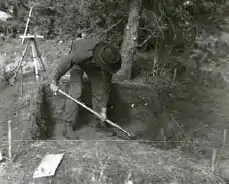Teklanika Archeological District
The Teklanika Archeological District is a 22-acre (8.9 ha) collection of archeological sites located on a knoll overlooking the Teklanika River, that was listed on the U.S. National Register of Historic Places in 1976.[2] It includes two contributing sites designated HEA-1 and HEA-2. It includes sites interpreted by archaeologists as a camp and an animal facility. The district was listed on the National Register for its potential to yield information in the future.[2]
Teklanika Archeological District | |
Alaska Heritage Resources Survey
| |
 Archaeologist Frederick West excavating at Teklanika, undated NPS photo | |
| Location | Address restricted[1], Denali Borough, Alaska, USA |
|---|---|
| Area | 22 acres (8.9 ha) |
| NRHP reference No. | 76000171[2] |
| AHRS No. | HEA-085 |
| Added to NRHP | January 31, 1976 |
The site was discovered in 1960. It is a site where loess is deposited by wind, building up the terrain and burying campfire sites of early humans. Work in the 1960s and 1970s suggested that artifacts of the site were more than 10,000 years old, then later it was suggested that the site was less than 8,000 years old.[3]
HEA-1, also known as Teklanika West, was studied in 2009 by archeologists Ben Potter and Sam Coffman, who found more than 1,500 artifacts, including remains of caribou, sheep, and bison which were useful in radiocarbon dating the site to be more than 10,000 years old after all.[3]
References
- Federal and state laws and practices restrict general public access to information regarding the specific location of this resource. In some cases, this is to protect archeological sites from vandalism, while in other cases it is restricted at the request of the owner. See: Knoerl, John; Miller, Diane; Shrimpton, Rebecca H. (1990), Guidelines for Restricting Information about Historic and Prehistoric Resources, National Register Bulletin, National Park Service, U.S. Department of the Interior, OCLC 20706997.
- "National Register Information System". National Register of Historic Places. National Park Service. July 9, 2010.
- "Ancient Hunters near the Teklanika River". National Park Service. Retrieved June 7, 2017.

.svg.png.webp)